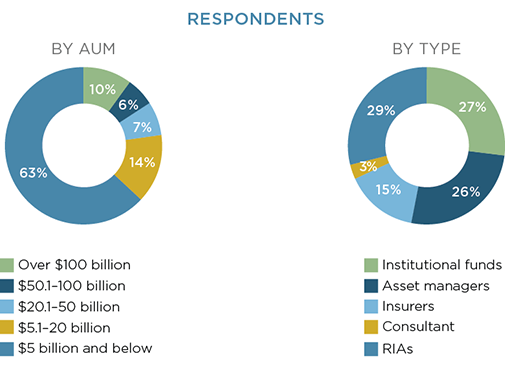Institutional assets are flowing into exchange-traded funds (ETFs) as U.S. institutions integrate them into essential portfolio functions ranging from risk management and liquidity enhancement to the generation of income and yield. As such, ETFs appear to be on track to eventually becoming as common in institutional portfolios as stocks, bonds and derivatives.
This steady advance of ETFs within institutional portfolios is one of the main findings of the Greenwich Associates 2016 U.S. Exchange-Traded Funds Study, which focuses primarily on the investment behavior of U.S institutions currently investing in ETFs. Although only about 1 in 5 U.S. institutions overall currently invest in ETFs, those that do generally have multiple years’ experience investing in the funds.
These institutions see ETFs first and foremost as tools for obtaining strategic investment exposures, often holding them alongside stocks, bonds, and derivatives. However, investors are also taking advantage of ETF traits like liquidity, ease of use and quick market access to apply the funds across a broad and expanding range of portfolio applications.
Overall, institutional ETF users invest an average of 21% of total assets in ETFs—up from 19% in 2015. Those allocations are likely to grow in 2017. Forty-seven percent of equity ETF investors and 38% of bond ETF investors expect to increase their allocations to the funds in the year ahead.
Demand is being fueled by several powerful trends:
- ETFs are being viewed as a new class of financial instrument. In addition to using ETFs alongside other vehicles in their portfolios 52% of institutions that use derivatives to access beta say they have replaced an existing derivatives position with an ETF in the past year, and one-third of the institutions in the study plan to do so in the next year. ETFs have evolved within institutional portfolios from a complement to mutual funds to an alternative to derivatives with unique benefits of their own.
- Institutions are using smart beta ETFs to address challenges in their portfolios. Growing numbers of institutions are turning to innovative ETF exposures to help navigate the challenges posed by low interest rates and increasing market volatility. The share of institutional ETF users investing in smart beta ETFs increased to 37% in 2016 from 31% in 2015. The two most popular fund types in this category are minimum-volatility ETFs and dividend/equity-income ETFs. The strong demand for these funds is reflective of the challenges facing institutional investors today, including the need for yield and concerns about increased market volatility in the current rate environment. Of institutions currently investing in smart beta ETFs, 44% plan to increase their allocations to the funds in the next year.
- Demand for ETFs is being fueled by the growth in multi-asset funds. Fifty-two percent of the asset managers in the study use ETFs as part of multi-asset funds managed for clients. That share is up sharply from the 35% of asset managers employing ETFs in these funds in 2015.
- Bond ETF adoption is closing the gap on equity ETFs. In 2016, assets in U.S.-domiciled bond ETFs grew by nearly 26% to $428 billion, far outpacing the 18% growth in U.S. equity ETFs.1 In addition to the 38% of current bond ETF users expecting to increase allocations, 17% of current non-users are considering investing in the funds in the year ahead.
- Past impediments to institutional use are giving way. Factors that in the past limited institutional investment in ETFs appear to be receding. Fewer institutions are expressing concerns about ETF liquidity and expenses. In fact, many institutions are introducing the funds into their portfolios specifically to enhance liquidity and reduce costs. Meanwhile, explicit prohibitions or limitations against ETF investments are becoming less common in both equities and fixed income. In 2015, nearly a quarter of non-users said they were prevented from investing in fixed-income ETFs by internal investment guideline restrictions. That share fell to 19% in 2016.
Between October 2016 and January 2017, Greenwich Associates interviewed 187 institutional investors for its 2016 U.S. Exchange-Traded Funds Study. That research sample encompassed a wide range of institutions, including 50 institutional funds, 48 asset managers, 29 insurance companies, five investment consultants, and 55 RIAs.
Participants in this year’s study manage a total $6.668 trillion in assets. Over a third have assets under management (AUM) of more than $5 billion, about one-quarter manage more than $20 billion, and 10% have AUM in excess of $100 billion.


